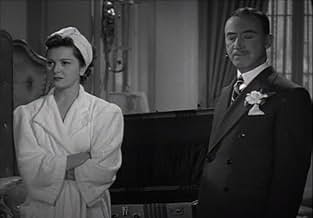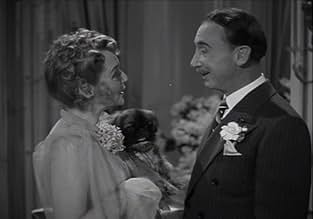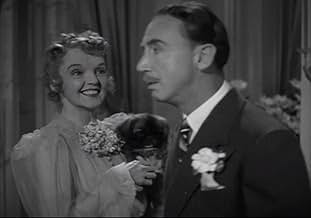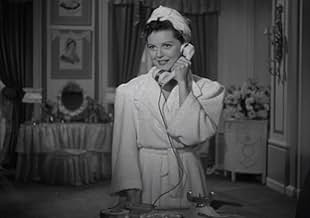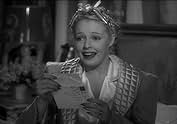AVALIAÇÃO DA IMDb
6,2/10
567
SUA AVALIAÇÃO
Adicionar um enredo no seu idiomaA drunken college boy invites a taxi dancer to spend the weekend at his snobbish school.A drunken college boy invites a taxi dancer to spend the weekend at his snobbish school.A drunken college boy invites a taxi dancer to spend the weekend at his snobbish school.
- Direção
- Roteiristas
- Artistas
- Prêmios
- 1 vitória no total
Peter Lind Hayes
- Skel
- (as Peter Hayes)
Ernie Alexander
- Parking Attendant
- (não creditado)
Rod Bacon
- College Boy
- (não creditado)
Lee Bennett
- College Boy
- (não creditado)
Avaliações em destaque
A little background on the origins of this film--- The film is entertaining and well acted if over the top in spots. Frank Nugent, veteran film critic at The New York Times, called it "the best social comedy of the year."(8/31/1939). Nugent also admires the actors "because they all admirably served the very high and rare cinematic purposes of social satire, deliberately rigged from the underprivileged viewpoint, and – even in its affected callowness-- more brutally acidulous than Claire Luce ever dreamed of being." The person most responsible for the story and dialogue was Jane Hall who wrote a 150 page film treatment for "These Glamour Girls," with Marion Parsonnet in the late summer of 1938. They also wrote the screenplay. Cosmopolitan (Yes! It used to be a literary magazine) then commissioned Hall to turn her treatment into a book-length novel for its December 1938 issue.
Hall's stories about the romantic predicaments of the smart young set appealed to harassed young housewives and working women; several were published in national magazines between 1936 and 1942. Her snappy dialogue caught the notice of MGM and in October 1937 she was offered a contract as a scenarist; she remained in Hollywood for much of the next three years. (For a time Scott Fitzgerald wrote in the office next to her.)
Hall and her beloved fox terrier Kate (rescued during the 1938 floods in Los Angeles) were the October 1939 Cosmopolitan cover girls. Illustrator Bradshaw Crandell whose iconic cover girls were usually anonymous put "Jane Hall MGM" on the dog tag.
This film (and her stories) reflect the values in Hall's background. Her candid and refreshing take on society life in New York City and on eastern campuses stems from her childhood in a tiny desert town in Arizona (Salome) and in Manhattan Beach, CA. At 15, following the death of her widowed mother, she came to live with her aunt and uncle in Manhattan. Over the next five years, despite their huge losses during the Depression, her guardians saw to it that she met glamour girls and boys very much like the young college men and women in the film. Kingsford College is a take-off on Princeton University where she attended house parties. A keen observer, Hall drew on her experiences as a New York debutante in her writing. Could that be why the young heroine in the film is called Jane?
Hall's stories about the romantic predicaments of the smart young set appealed to harassed young housewives and working women; several were published in national magazines between 1936 and 1942. Her snappy dialogue caught the notice of MGM and in October 1937 she was offered a contract as a scenarist; she remained in Hollywood for much of the next three years. (For a time Scott Fitzgerald wrote in the office next to her.)
Hall and her beloved fox terrier Kate (rescued during the 1938 floods in Los Angeles) were the October 1939 Cosmopolitan cover girls. Illustrator Bradshaw Crandell whose iconic cover girls were usually anonymous put "Jane Hall MGM" on the dog tag.
This film (and her stories) reflect the values in Hall's background. Her candid and refreshing take on society life in New York City and on eastern campuses stems from her childhood in a tiny desert town in Arizona (Salome) and in Manhattan Beach, CA. At 15, following the death of her widowed mother, she came to live with her aunt and uncle in Manhattan. Over the next five years, despite their huge losses during the Depression, her guardians saw to it that she met glamour girls and boys very much like the young college men and women in the film. Kingsford College is a take-off on Princeton University where she attended house parties. A keen observer, Hall drew on her experiences as a New York debutante in her writing. Could that be why the young heroine in the film is called Jane?
It may be lightweight fare, but the movie's still a revealing glimpse of the upper 1% of the 1930's. There's heartache aplenty when rich boy (Ayers) dates taxi dancer (Turner) from lower 99% and then stands her up in front of his snooty social circle. She's humiliated, to say the least, and we feel for her. Rich boy, Phil, has a lot to learn about life and people, and the remainder shows him trying to get things straight.
It's an MGM production so the glossy upper crust is spread on convincingly, from the high fashion clothes to the glittering ballrooms to the carefree attitudes. At the same time, the girls don't disappoint in the glamour department just as the title promises. We also get a cross-section of personality types from bitchy Daphne to misfit Betty to nice girl Carol. So it's lots of eye candy with some clumsy humor thrown in (the drunken Harvard man). But then, the movie turns dark near the end, and we see the downside of all the glitter (the stockbroker dad; an onrushing train). Notice, however, how biology ultimately triumphs over class.
The competition may be heavy but Turner shines as the working girl with stars in her eyes. But I especially like a rather obscure Jane Bryan (Carol) who projects an effortless inner radiance. Too bad that she left the business so soon. All in all, the film's a diverting peek into class mores of the time, a topic I expect still resonates with today's 99%.
It's an MGM production so the glossy upper crust is spread on convincingly, from the high fashion clothes to the glittering ballrooms to the carefree attitudes. At the same time, the girls don't disappoint in the glamour department just as the title promises. We also get a cross-section of personality types from bitchy Daphne to misfit Betty to nice girl Carol. So it's lots of eye candy with some clumsy humor thrown in (the drunken Harvard man). But then, the movie turns dark near the end, and we see the downside of all the glitter (the stockbroker dad; an onrushing train). Notice, however, how biology ultimately triumphs over class.
The competition may be heavy but Turner shines as the working girl with stars in her eyes. But I especially like a rather obscure Jane Bryan (Carol) who projects an effortless inner radiance. Too bad that she left the business so soon. All in all, the film's a diverting peek into class mores of the time, a topic I expect still resonates with today's 99%.
This film is a good example of MGM's early attempts to establish a screen persona for Lana Turner. Her role here as a dance hall hostess is similar to the rags-to-riches roles that Joan Crawford had successfully played early in her own career a decade earlier. However, Lana Turner just wasn't made to wear rags, and it wasn't until MGM put her into satins and jewels that audiences really responded.
This film is an entertaining mix of romantic comedy and social class commentary. The university town ("Kingsford") is obviously patterned after Princeton, NJ. (The eating clubs that host the prom in the film are still very much thriving institutions at Princeton.) There's a strong supporting cast and the condescending attitudes of some of the upper crust girls toward Turner is refreshingly realistic. (Amusingly, Turner apparently has red hair in this black-and-white film. Other characters refer to her as "Red").
This film is an entertaining mix of romantic comedy and social class commentary. The university town ("Kingsford") is obviously patterned after Princeton, NJ. (The eating clubs that host the prom in the film are still very much thriving institutions at Princeton.) There's a strong supporting cast and the condescending attitudes of some of the upper crust girls toward Turner is refreshingly realistic. (Amusingly, Turner apparently has red hair in this black-and-white film. Other characters refer to her as "Red").
How pretty, sexy, and vivacious Lana Turner was, and she's shown to great advantage in "These Glamour Girls," a 1939 film about a weekend of house parties at an upper-class college. Turner plays a Jane, a taxi dancer at the Joy Lane Dance Hall who meets Phil (Lew Ayres), a college student from an old family who's at the Joy Lane slumming with his pals. While drunk, he invites her to the big weekend at Knightsbridge College. When she arrives, he's forgotten who she is and he already has a date. He convinces her to stay anyway, and while having a good time, she gets a glimpse of what the upper class is really like and what's important to them: background, the right schools, social standing, and money. And don't forget the booze.
This is an okay story with some good performances from Turner, Ayres, Richard Carlson, Marsha Hunt, Ann Rutherford, Tom Brown, Jane Bryan, and Anita Louise. Rutherford's with a man who doesn't want her, and Louise is the resident bitch. Bryan is dating Ayres, but it's obvious she's in love with Carlson. Marsha Hunt plays Betty, a 23-year-old still hanging with the college crowd in the hopes of nabbing a man. When she overhears someone say she should get married soon before she misses the boat, she panics. It's themes like this in the '30s-'50s that are hard to stomach, and frankly, it brings down this film. The resolution of the Betty arc is very out of place.
Most of the actors were in their twenties, but Turner was only 18 and Ayres was 30, a little old for a college kid - but he was always a very likable actor. Except for Turner, whose charisma leaps out of the screen, there isn't anything special about "These Glamour Girls."
This is an okay story with some good performances from Turner, Ayres, Richard Carlson, Marsha Hunt, Ann Rutherford, Tom Brown, Jane Bryan, and Anita Louise. Rutherford's with a man who doesn't want her, and Louise is the resident bitch. Bryan is dating Ayres, but it's obvious she's in love with Carlson. Marsha Hunt plays Betty, a 23-year-old still hanging with the college crowd in the hopes of nabbing a man. When she overhears someone say she should get married soon before she misses the boat, she panics. It's themes like this in the '30s-'50s that are hard to stomach, and frankly, it brings down this film. The resolution of the Betty arc is very out of place.
Most of the actors were in their twenties, but Turner was only 18 and Ayres was 30, a little old for a college kid - but he was always a very likable actor. Except for Turner, whose charisma leaps out of the screen, there isn't anything special about "These Glamour Girls."
A year after appearing together in "Love Finds Andy Hardy", Lana Turner and Ann Rutherford were paired up in two 1939 films: "These Glamour Girls" and "Dancing Co-Ed". Beyond having a college setting (with Turner playing an outsider), there was little similarity between the two films. Although much more ambitious, "Those Glamour Girls" is not in the same class as the more entertaining and lyrical "Dancing Co-Ed".
It is the standard depression era story contrasting the shallowness of the upper class and their moral depravity with the virtuous working class. Direction-less rich boy Philip S. 'Phil' Griswold III (Lew Ayres) invites dance club hostess Jane Thomas (Turner) to spend the weekend at his elite college where the various clubs are hosting a big dance.
Jane receives a mixed welcome from his crowd, the rich boys view her as an exotic novelty and the snooty girls as an inferior. As always happens in this standard story the rich people learn a lot of life lessons from the poor girl and are transformed into better, more responsible and mature citizens.
Turner is horribly miscast as the tough girl with a heart of gold. She has little chemistry with Ayres and looks grumpy and distressed most of the time. Her biggest assets were her smile and comic timing, making her much better physically as the wholesome girl-next-door than in this type of "too serious" role. Except for one very nice dance number at the midway point of the film there is nothing to even suggest that she would become a star.
This early twenties coming-of-age story tries to tackle more issues than it can reasonably handle, too many issues mean at best a superficial treatment for each. The results are disappointing as little of the interplay and character growth is convincing.
One exception is an excellent performance by Marsha Hunt as Betty Ainsbridge, a slightly older girl who has been left behind by her contemporaries and is trying to fit in with the younger crowd. Hunt (also a "Andy Hardy" veteran) does a great job of conveying the insecurities and desperation of a woman of that era confronting a future that holds fewer and fewer options for her. Unfortunately, her story is almost incidental to the main action of the film.
Then again, what do I know? I'm only a child.
It is the standard depression era story contrasting the shallowness of the upper class and their moral depravity with the virtuous working class. Direction-less rich boy Philip S. 'Phil' Griswold III (Lew Ayres) invites dance club hostess Jane Thomas (Turner) to spend the weekend at his elite college where the various clubs are hosting a big dance.
Jane receives a mixed welcome from his crowd, the rich boys view her as an exotic novelty and the snooty girls as an inferior. As always happens in this standard story the rich people learn a lot of life lessons from the poor girl and are transformed into better, more responsible and mature citizens.
Turner is horribly miscast as the tough girl with a heart of gold. She has little chemistry with Ayres and looks grumpy and distressed most of the time. Her biggest assets were her smile and comic timing, making her much better physically as the wholesome girl-next-door than in this type of "too serious" role. Except for one very nice dance number at the midway point of the film there is nothing to even suggest that she would become a star.
This early twenties coming-of-age story tries to tackle more issues than it can reasonably handle, too many issues mean at best a superficial treatment for each. The results are disappointing as little of the interplay and character growth is convincing.
One exception is an excellent performance by Marsha Hunt as Betty Ainsbridge, a slightly older girl who has been left behind by her contemporaries and is trying to fit in with the younger crowd. Hunt (also a "Andy Hardy" veteran) does a great job of conveying the insecurities and desperation of a woman of that era confronting a future that holds fewer and fewer options for her. Unfortunately, her story is almost incidental to the main action of the film.
Then again, what do I know? I'm only a child.
Você sabia?
- CuriosidadesFirst film where Lana Turner receives top billing.
- Citações
Jane Thomas: Listen, you wisecracking, bad-mouthing glamour girl. I've had all your kind of friend that I can use. Why, I wouldn't breathe the same air with you and your pedigree polo shirts for another five minutes.
- ConexõesFeatured in Discovering Film: Lana Turner (2015)
- Trilhas sonorasLoveliness
(1939)
Music by Edward Ward
Lyrics by Bob Wright and Chet Forrest
Played during the opening credits
Sung by Dale Fellows (uncredited) at the social
Hummed by Lana Turner (uncredited)
Played as background music often
Principais escolhas
Faça login para avaliar e ver a lista de recomendações personalizadas
Detalhes
- Data de lançamento
- País de origem
- Idioma
- Também conhecido como
- These Glamour Girls
- Locações de filme
- Empresa de produção
- Consulte mais créditos da empresa na IMDbPro
Bilheteria
- Orçamento
- US$ 403.000 (estimativa)
- Tempo de duração
- 1 h 19 min(79 min)
- Cor
- Proporção
- 1.37 : 1
Contribua para esta página
Sugerir uma alteração ou adicionar conteúdo ausente




